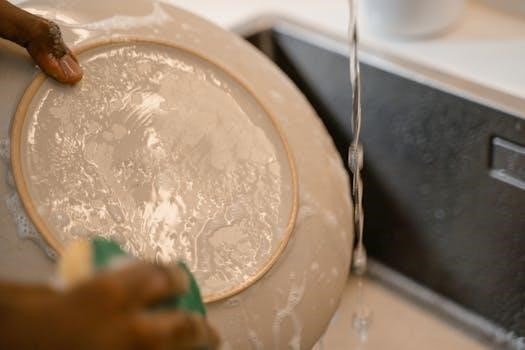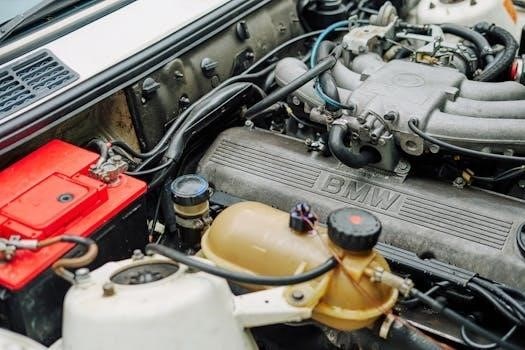A․O․ Smith Water Softener Manual⁚ An Overview
This manual provides comprehensive information for A․O․ Smith water softeners, covering installation, operation, and maintenance․ It includes details on various models like the AO-WH-SOFT-350, 400T, and 450T․ Find step-by-step instructions and troubleshooting tips for optimal performance and long-term use of your system․ This guide aids in understanding your unit․
Understanding A․O․ Smith Water Softener Models
A․O․ Smith offers a range of water softener models designed to meet diverse household needs, each with specific features and capabilities․ The AO-WH-SOFT-350 is a popular choice, known for its efficiency in removing hardness minerals like calcium and magnesium․ Moving up the line, the AO-WH-SOFT-400T model provides enhanced capacity and might include additional features for improved water softening․ The AO-WH-SOFT-450T, often the most advanced in the series, typically boasts the highest grain capacity, making it ideal for larger homes or those with particularly hard water․ These models are designed to reduce scale buildup, improve appliance efficiency, and enhance the quality of water used for dishwashing and laundry․ Understanding the differences between these models is crucial for selecting the right system for your home․ Factors like water hardness levels, household size, and water consumption habits should be considered before choosing a specific A․O․ Smith water softener․
Key Features of A․O․ Smith Water Softeners
A․O․ Smith water softeners are equipped with several key features designed for efficient and reliable performance․ Many models come with a built-in dirt and sediment filter, enhancing water quality before the softening process begins․ The fine mesh resin used in these softeners is effective in reducing hardness minerals, ensuring softer water throughout your home․ These systems often feature high-tech regeneration techniques, optimizing salt usage and minimizing waste․ Some models incorporate dry salt storage features, which prevent excess water in the brine tank․ The control valves are designed for smooth operation, facilitating both normal water flow and the regeneration cycle․ A․O․ Smith softeners are built to lessen scale buildup in your plumbing and appliances, prolonging their lifespan․ They aim to improve the efficiency of dishwashing and laundry, leading to better cleaning results․ The systems are designed to be user-friendly, with clear instructions for settings and maintenance, making them a practical choice for homeowners․
Installation Guide for A․O․ Smith Softeners
The installation of your A․O․ Smith water softener requires careful attention to ensure optimal performance and longevity․ Begin by selecting a suitable location, preferably near your main water supply and drain, ensuring enough space for maintenance and access․ The unit should be installed before the water heater, and after the pressure tank in well water systems․ A pressure-reducing valve might be necessary in certain situations to manage water pressure․ Before starting, check the box contents to verify all necessary parts are included․ Ensure you have an inlet shutoff valve to control water flow during installation and maintenance․ Proper plumbing to the unit’s bypass valve inlet is crucial for correct functionality․ Carefully follow the detailed instructions provided in the manual, which includes safety messages and warnings․ It is essential to understand the cautions and notes before starting the setup․ The manual provides specific guidance on system configuration and how to connect to the cold water supply․ Correct installation is critical for the softener to function properly, so take your time;
Step-by-step Installation Instructions
Begin the installation by turning off the main water supply to your home․ Next, carefully unpack all components and verify against the parts list in the manual․ Locate a suitable place for installation, ensuring it is level and close to both a cold water supply and a drain․ Connect the inlet and outlet fittings to the softener, ensuring to use appropriate plumbing tape to prevent leaks․ Install the bypass valve, which allows water to flow even if the softener isn’t working․ Before proceeding, confirm that all connections are snug and there are no leaks․ Once the plumbing is complete, attach the drain line to a suitable drainage point․ If you have well water, make sure the softener is installed after the pressure tank․ Then plug in the transformer․ Initiate a manual regeneration cycle and let the softener rinse until the water is clear and without any air․ Finally, carefully load the brine tank and allow the unit to function normally․ Double check all connections and settings before finishing․
A․O․ Smith Water Softener Operation
The A․O․ Smith water softener operates by removing hard minerals like calcium and magnesium from your water supply․ During normal operation, water flows through the control valve and resin bed where these minerals are trapped․ This process softens the water, improving its quality for household use․ The softener’s control valve regulates the flow of water during both softening and regeneration cycles․ Periodically, the unit goes through a regeneration cycle to flush out trapped minerals using a brine solution․ This cycle is essential for maintaining the softener’s effectiveness․ Many A․O․ Smith models also feature a dry salt storage function, which keeps the salt from caking․ The softener is designed to work on a timer or on-demand basis, depending on the model and settings․ By understanding the normal operation and regeneration cycles, you can ensure that your water softener functions efficiently and provides you with soft water․
Normal Operation and Regeneration Cycles
In normal operation, an A․O․ Smith water softener processes incoming water through a resin bed․ This resin captures hard minerals such as calcium and magnesium, effectively softening the water for household use․ The control valve manages the flow of water, ensuring it passes through the resin for optimal softening․ Once the resin bed becomes saturated with these minerals, the softener initiates a regeneration cycle․ This cycle involves backwashing to remove accumulated sediment, followed by the introduction of a brine solution to replenish the resin․ The brine solution flushes out the trapped hard minerals, which are then discharged from the system․ A final rinse cycle prepares the resin for another round of softening․ The regeneration cycle is crucial for maintaining the softener’s efficiency and is typically scheduled based on water usage or time; This process ensures consistent delivery of soft water by periodically renewing the resin’s capacity․ Understanding these cycles is key to proper maintenance․

Specific A․O․ Smith Models
This section details specific A․O․ Smith water softener models, including the AO-WH-SOFT-350, AO-WH-SOFT-400T, and AO-WH-SOFT-450T․ Each model offers unique features and specifications tailored to different household needs․ Explore the individual characteristics of these units for informed selection and usage․
AO-WH-SOFT-350 Model Details
The A․O․ Smith AO-WH-SOFT-350 model is a whole-house water softener designed to reduce hardness by removing calcium and magnesium from your water supply․ This model is known for its efficient operation and is often recommended for smaller to medium-sized households․ The system comes with a user-friendly control valve and a brine tank that can store a significant amount of salt․ It features a built-in dirt and sediment filter, contributing to cleaner water throughout your home․ The AO-WH-SOFT-350’s design aims to lessen scale build-up in your plumbing, extending the lifespan of your appliances․ Installation typically requires an inlet shutoff valve and connection to the bypass valve․ This model is accompanied by a detailed owner’s manual that includes system configuration instructions and pre-installation guidance․ The unit’s functionality is focused on providing softened water for improved dishwashing, laundry, and overall water quality․ The AO-WH-SOFT-350 is built with high-quality resin and features advanced regeneration techniques for high performance and low energy consumption․ The manual emphasizes the importance of following safety instructions during installation to prevent any issues․ Always refer to the complete manual for detailed instructions on operation and maintenance․

AO-WH-SOFT-400T Model Specifications
The A․O․ Smith AO-WH-SOFT-400T model is engineered for households requiring a robust water softening solution․ This unit is specified to handle a 40,000-grain capacity, making it suitable for medium to larger families․ It effectively reduces hardness, preventing scale buildup in plumbing systems and appliances․ The AO-WH-SOFT-400T incorporates advanced features designed to optimize water softening efficiency․ Its design includes a user-friendly control valve that manages the water softening and regeneration cycles․ The unit’s specifications also involve a brine tank designed for efficient salt use and storage․ The softener includes high-quality resin and utilizes a high-tech regeneration process to ensure reliable performance․ The AO-WH-SOFT-400T is equipped with a built-in filter to trap sediments and debris, improving overall water quality․ The softener’s installation process involves connecting to the main water line and proper electrical connections․ This model also includes specifications for proper placement to ensure optimal efficiency․ The manual provides precise details on how to configure and use the water softener, including programming the settings for proper operation․ It is essential to consult the manual for specific installation requirements, safety information, and troubleshooting guidance․ The AO-WH-SOFT-400T ensures consistent soft water for various household uses, and this manual helps users maintain it effectively․
AO-WH-SOFT-450T Model Features and Usage
The A․O․ Smith AO-WH-SOFT-450T water softener is designed for larger households with higher water usage demands, featuring a 45,000-grain capacity․ This model is particularly effective in reducing scale buildup, enhancing the efficiency of dishwashers and laundry machines․ Its key features include a fine mesh resin that significantly reduces hardness and a built-in sediment filter to ensure the water is clean before softening․ The AO-WH-SOFT-450T employs an advanced control valve that manages the softening and regeneration cycles automatically․ The unit has a user-friendly interface for easy programming and monitoring․ It utilizes a brine tank designed for optimal salt usage and storage, ensuring a consistent supply for regeneration․ The softener incorporates high protection with low energy consumption, making it an efficient and environmentally friendly option․ The regeneration cycle is a vital part of its operation, ensuring the resin is cleaned and ready for use․ This model is also equipped with a dry salt storage feature to prevent clumping․ The manual provides comprehensive instructions on how to install and operate the unit, including details on connecting the water lines and electrical components․ The AO-WH-SOFT-450T is designed for long-term performance and is a reliable solution for any household needing consistent soft water․ Proper usage according to the manual will enhance its efficiency and longevity․

Maintenance and Troubleshooting
This section covers routine maintenance for your A․O․ Smith water softener, including salt level checks and cleaning․ It also provides solutions for common issues, plus guidance on when to contact A․O․ Smith support for further assistance if problems persist․
Routine Maintenance Procedures
Regular maintenance is crucial for the optimal performance and longevity of your A․O․ Smith water softener․ A key aspect is to consistently check the salt levels in the brine tank; it’s recommended to maintain a salt level that is a few inches above the water line․ Ensure you are using the correct type of salt as specified in your manual, such as pellet or crystal salt, and avoid rock salt, which can cause blockages․ Periodically inspect the brine tank for any salt bridges or buildup and break them up carefully․ Furthermore, it is advisable to clean the injector and venturi periodically to prevent clogs․ This may require disassembly, so refer to your specific model’s instructions for this procedure․ Also, check for leaks around fittings and connections; address any leaks to avoid water damage․ The resin bed should also be cleaned periodically using a water softener cleaner to remove deposits․ Lastly, always ensure the control valve is operating correctly and that there are no blockages․ These regular checks and maintenance steps will keep the system functioning effectively․
Troubleshooting Common Issues
When your A․O․ Smith water softener isn’t functioning correctly, several common issues might be the cause․ If you’re experiencing hard water, the first step is to check if the salt level in the brine tank is adequate․ Low salt levels are a frequent reason for poor performance․ Also, verify the bypass valve is set correctly for normal operation, not in bypass mode․ Another common problem is the system not regenerating properly; this can be due to a faulty timer or control valve․ Observe if the softener is going through its regeneration cycle or if there are any error codes displayed․ If the water softener is leaking, examine all connections and fittings for tightness and any cracks or damage․ Check the drain line for clogs or kinks as well․ If the system is constantly running, the control valve might be stuck or have a damaged seal; professional assistance may be needed in this case․ Also, verify there is power to the unit and that all settings are correctly configured․ Addressing these issues promptly can help restore your water softener’s function․
Contacting A․O․ Smith Support
If you’ve encountered issues with your A․O․ Smith water softener that you can’t resolve using the troubleshooting guide, reaching out to A․O․ Smith support is the next logical step․ They offer a range of options for customers seeking assistance․ You can begin by visiting their official website, which often includes a dedicated support section․ There, you can find FAQs, troubleshooting guides, and contact forms․ You may also be able to locate the phone number for their customer service line․ When contacting support, make sure to have your model number and purchase date readily available for faster assistance․ If the issue requires technical service, they will provide details on how to locate certified technicians near you․ A․O․ Smith has a network of plumbing contractors familiar with their products․ For non-urgent requests, using their online contact form allows you to explain your situation in detail․ A․O․ Smith is committed to helping customers resolve their issues efficiently․



